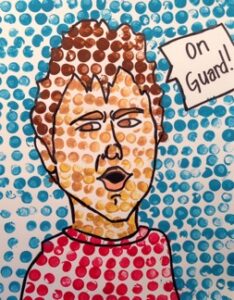Lesson: Lichtenstein Portraits
Roy Lichtenstein was an American Pop artist. His bold, colorful style took portraiture to a less serious place than it had been in history. He had fun with his portraits and often connected advertising and comic strip appearances. This lesson will help you create a fun portrait that guides your viewer to have an emotional response to the artwork.
Time Frame: 1 hour
Goals:
- Explore illustration and painting in the eyes of American Pop artist Roy Lichtenstein.
- Use portraiture to bridge a cultural connection between advertising and fine art.
- Read and learn about the artist, Roy Lichtenstein.
Materials:
- White cardstock or watercolor paper
- Magazine with portraits or a mirror
- Pencil and eraser
- Black Sharpie
- Acrylic paints
- Small paintbrush
- Unsharpened pencil for dots
Directions:
It is your job to create a fun portrait that guides your viewer to have an emotional response to the artwork: confused, happy, sad, laughing, etc. If looking though a magazine for a model, choose a portrait that shows emotion and a mouth that could be speaking. If using a live model from the art table, or a mirror for a self-portrait, make sure the model is (or you are!) making a face that could express emotion and looks as if they/you were speaking.
- Use a pencil to draw the basic lines of the face, neck, and shoulders. Then, draw in a word bubble to the side.
- Trace the lines with a black Sharpie. Erase the pencil lines.
- Choose your colors that will be used for the portrait. You’ll want only a few colors for the face, hair/hat, shirt, and background.
- Start with the background and fill in with rows of dots. These should be in lines as best as possible. You are recreating a “print” effect.
- Move to the next area, face, or shirt and try to line up the dots with the background dots. It’s ok if the colors touch the black marker – you will re-trace when it is dry.
- Once the paper is full of dots, use a small paintbrush to fill in the smaller areas like the eyes, lips, and glasses frame if there is one.
- Once the paint is dry, re-trace the Sharpie.
- Use the Sharpie to write a statement in the word bubble that you think the portrait could be saying. Think about how to make a statement with the word bubble. Help connect either a question or emotion with the word bubble and the portrait.
Tweak It:
- Use thought bubbles in addition to or instead of word bubbles.
- Draw several people in one picture in the same way.
- Create a large comic strip with the same method; use a 12 x 18 piece of paper and divide it into three sections.
- Draw animals instead of people.
- Choose a larger section that could be completely filled with color instead of dots.
© 2015 Arts For Life
